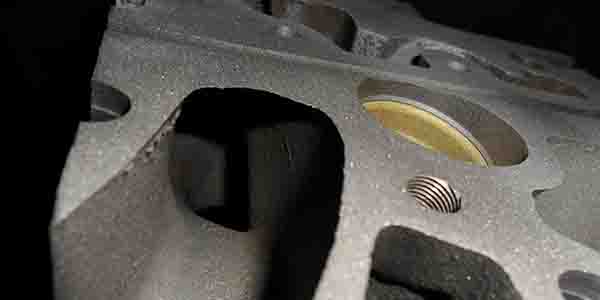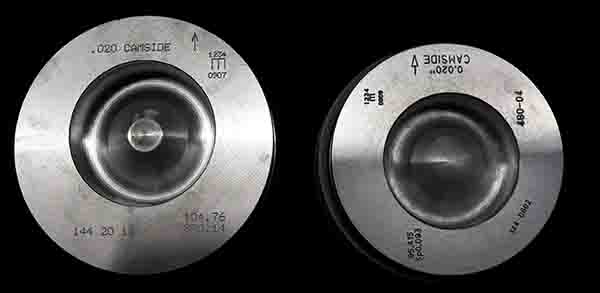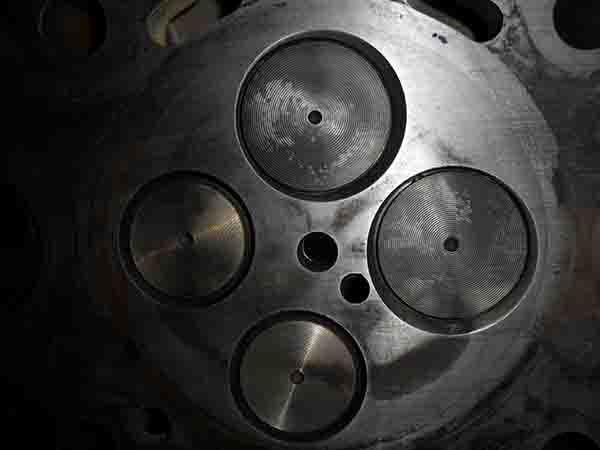There are many techniques of cylinder head porting for diesel engines, but which one works for the application? What is the appropriate strategy for maximizing diesel cylinder head performance? There are many videos and pictures of diesel cylinder heads being ported but what actually works? These questions are often asked but never really investigated.
Diesel engine intake ports and combustion chambers are unique to the way the engine performs. If you look inside the intake runner of a diesel engine, you’ll find that it is very different from that of a gasoline engine. In many cases, I believe there still needs to be an understanding of what is going on in the ports of a diesel cylinder head, which may help improve on proper port design.

When looking at the intake runner you will notice that the port looks like it starts off at the face of the head like the size of a sewer pipe and then narrows down to the size of a pencil eraser as it enters the valve area. That is a big exaggeration but is somewhat true – it appears that the intake port is choking down. But, the port does actually curve as it narrows to the intake valve. Also, when working with four valve per cylinder diesel engines, you notice that the intake and exhaust ports are rotated in the combustion chamber. In other words, the two intake valves are not at the top of the combustion chamber and the exhaust valves are not at the bottom of the combustion chamber as they are in a gasoline engine.
When building a performance diesel engine, you need to understand why the ports were created this way. I say this because there have been instances where the “ported” cylinder head was removed and ported properly and achieved more power. The reason for these designs of the ports and combustion chamber shape is for the enhancement of swirl. A certain amount of port swirl is necessary for the diesel engine to operate efficiently.
Since most on-road diesel engines utilize a turbocharger, here is an example of how air is directed into the cylinder. Compressed air from the turbocharger enters the intake manifold. When the intake valve opens, compressed air enters the intake port and starts its journey toward the intake valve. Before the air reaches the intake valve it begins to pick up velocity as the port narrows. Because the port is necked down and curved, as the intake valve opens the air enters the cylinder in a swirl fashion.

The intake valves are positioned in the combustion chamber in a clocked fashion so air will hit the cylinder wall and continue to swirl as it travels down to the piston. The swirl helps to fill the cylinder. The swirling air fills the top of the piston, the pre-ignition chamber also known as the “bowl.” At this point the piston has reached bottom dead cylinder and begins its journey upward in the bore toward the cylinder head. With the intake valves closed, the swirling air in the piston bowl rapidly increases somewhat like a tornado. As the swirling air in the cylinder is compressed by the piston its temperature increases rapidly.
This tornado-like action continues along with the heat and, with the aid of electronic injection, a small amount of fuel is injected into the cylinder. These droplets of fuel are super fine and the mixture starts to ignite. Just as the piston reaches top dead center fuel is injected and the fine droplets are slung inside the piston bowl where they immediately ignite and an explosion takes place. This very violent explosion forces the piston back down with a very high expansion ratio, creating torque at very low rpm.
In order to properly port our diesel heads to maximize this swirl there are some things to consider. First, let’s go back and take a look at the purpose of cylinder head porting. The main goal of cylinder head porting is to enhance the design and layout of the intake and exhaust ports along with the combustion chamber of the chosen cylinder head. This does not mean that we are just going to make everything bigger. The only way to find the areas in need of enhancing would be the use of a flow bench.
Second, we need to know the limits of the ports for the specific application. In other words, what are you looking to gain out of the cylinder head and is there enough material to alter the port? Sometimes because of limited head castings the port area needed for the application may extend past what the cylinder head was intended for.

Third, remember that a diesel cylinder head and gasoline cylinder head are two totally different applications. What works for one may not work as well for the other. A diesel engine has a totally different criterion to meet when it comes to cylinder filling and evacuation of the intake and exhaust system to produce power.
Here are things to consider when porting diesel cylinder heads. When you look at and through the intake ports pay close attention to the area that will be creating the swirl. The intake port will benefit from enhancement to the swirl portion of the port. This means a good clean up of rough casting and smoothing out the entire port.
The valve job will also be very critical. Diesel engines tend to have a very crude valve seat area and valve throats in the bowl area. Defining a valve seat angle with the proper size valve can be determined after the bowl area is corrected. Also, take the intake and exhaust valves and define a back-cut that will allow for enough valve seat surface area. Valve seat surface area will be critical in helping cool the valves.
As for the exhaust ports, try not to focus on creating huge ports but improve the throat and bowl areas along with the valve guide bosses extruding into the port. Since a diesel is turbocharged, the ports will benefit from a good clean-up but size will be important. The exhaust gases coming through the ports and into the manifold or header have to keep velocity speed up. This velocity speed is what drives the turbo and too big of a port will produce turbo lag.

Some cylinder heads can also benefit from extrude honing. Extrude honing provides a good way to clean up the intake and exhaust ports and even the exhaust manifolds. An engine dyno is also a big help with the porting of diesel cylinder heads.
Modifying a diesel cylinder head today takes me back to the good old days of the 1980s through the ’90s. Back then, for a high performance gasoline engine, there were limited choices of cylinder heads. At that time, nearly everything was cast iron and if you did have enough money to purchase one of the few aluminum heads available, they were in raw form. Many hours were required on the valve job and port design which equal countless hours of flow testing and porting to achieve good but minimal results when compared to today’s cylinder head castings.

The purpose of cylinder head porting is to find high velocity low-pressure areas that can be improved upon, avoiding low velocity high pressure areas. The biggest key to porting is to keep the task as simple as possible.
Try not to reinvent the wheel. Manufacturers have spent countless hours of testing to make today’s diesel engines perform at the level they do today. Most manufactured cylinder heads are going to benefit from multiple valve seat angles and good bowl work. For most applications a good clean-up with a good valve job and some bowl work can produce lower E.T.s and a substantial increase in MPH.
As we all know, there have been expensive “ported” diesel cylinder heads removed from an engine and correctly ported. Then the heads were reinstalled to yield more MPH better elapsed time at the drag strip. Try to seek help from someone with flow bench experience for help in porting your heads if you are unsure about what to do.













